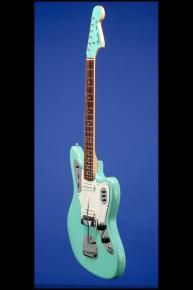One Of Only Four 1964 Sea Foam Green Jaguars…
This unbelievable 'Glam Rock' guitar weighs just 7.80 lbs. and has a nut width of 1 5/8 inches and a scale length of 24 inches. Offset asymmetrical 14 inch wide solid alder body. One-piece maple neck with a medium-to-thick profile. Brazilian rosewood 'veneer' fretboard with 22 original medium-thin frets and clay dot position markers. Headstock with matching "Sea Foam Green" finish and decal with "Fender" logo in gold with black trim, "Jaguar" in black in bold letters, and three patent numbers in black below. With "Offset Contour Body" at the ball end of the headstock. Single "butterfly" string tree with metal spacer. Individual Kluson 'single-line' Deluxe tuners with oval metal buttons and "D-169400 / Patent No." stamped on the underside - except for the 'low E' tuner which is blank (but absolutely original) on the underside. Four-bolt neck plate with the serial number "L45471" between the top two screws. The neck is stamped "1 jUL 64 B". Two white oblong Strat-like pickups with notched metal side plates and perfectly matched outputs of 6.89k and 6.90k. Three-layer "minty" (white/black/white) plastic pickguard. Two controls (one volume, one tone) and jack socket on lower metal plate adjoining pickguard on treble side, selector switch and two roller controls (one volume, one tone) on upper metal plate adjoining pickguard on bass side, and three slide switches on metal plate inset into the pickguard on the treble side. Black plastic knobs with eight sides and white markings. The potentiometers are dated "304-6408" and "304-6423" (Stackpole, February and June 1964). Jaguar / Jazzmaster floating tremolo and bridge with adjustable mute. This exceptionally rare custom color Jaguar is in exceptionally fine (9.00) condition. There are several surface chips/indentations on the back and edges of the body. There are three small 'punctures' - no larger than a match-head, on the back. There is an area of wear, approximately 3 1/2 inches by 1/2 inch (through to the wood) on the lower edge of the treble waist. There is hardly any discoloration of the rich Sea Foam Green color - the only areas that are slightly 'greener' are on the edges of the treble and bass horns. The original frets and the fret board show very little sign of wear. The matching headstock shows very little wear apart from on the decal where part of the "U" in JAGUAR has worn away. Complete with the original tremolo arm, bridge cover, black leather strap and even the original "Fender Instruction Manual for Jaguar" with matching serial number. Housed in the original Fender black hardshell case with black leather ends and burnt orange plush lining (9.00).
Only four Foam (or Sea Foam) Green Jaguars from this year are known to have been made. We currently have in our inventory one of the other three "L46649" which was originally owned by Marc Bolan (T Rex) and then Henri Padovani (The Police) - and that is the only one known with gold hardware.
"Not content with the relatively expensive Jazzmaster, Fender introduced a new top-of-the-line model in 1962: the Jaguar. [The pricelist offered a basic sunburst Jaguar at $379.50; a similar Jazzmaster was $349.50]. Another offset-waist multi-control instrument, the Jag seemed an attractive proposition, but still failed to dent the supremacy of Fender's dynamic duo, the Tele and the Strat...The Jag used a similar offset-waist body shape to the earlier Jazzmaster, and also shared that guitar's separate bridge and vibrato unit, although the Jaguar had the addition of a spring-loaded string mute at the bridge. Fender rather optimistically believed that players would prefer a mechanical string mute to the natural edge-of-the-hand method. They did not. There were some notable differences between the Jaguar and Jazzmaster. Visually, the Jag had distinctive chromed control panels, and was the first Fender with 22 frets. Its 24" (610mm) scale-length ('faster, more comfortable') was shorter than the Fender standard of 25" (635mm) and closer to that of Gibson. It gave the Jag a different playing feel compared to other Fenders. The Jaguar had better pickups than the Jazzmaster. They looked much like Strat units but had metal shielding added at the base and sides, no doubt as a response to the criticisms of the Jazzmaster's tendency to noisiness. The Jag's electrics were yet more complex than the Jazzmaster's, using the same rhythm circuit but adding a trio of lead-circuit switches...The Jaguar was offered from the start in four different neck widths, one a size narrower and two wider than normal (coded A, B, C or D, from narrowest to widest, with 'normal' B the most common)" (Tony Bacon, 50 Years of Fender, p. 36).
Translate:









